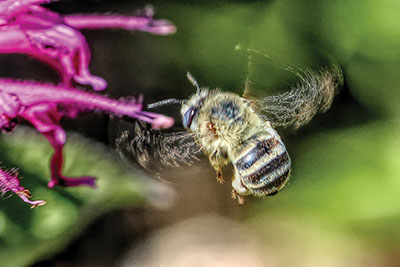
Imagine being born with wings. As you chew your way out of your cell, you slowly become aware of something weird. In addition to the requisite six legs and two antennae, you also have these…um…well, what are they exactly? According to the book, they are not appendages but simply outgrowths of the cuticle. As you continue to excavate chunks of wax with your mandibles, you wonder where you learned the words “appendage” and “cuticle.” And what is simple about it? You finally pull yourself free. Wow. Life is going to be some kind of trip!
Indeed, our little bee read the right books. Wings are not appendages, but arise from a structure called a wing bud.1 Pretend for a minute that you are inside the thorax of a bee chewing some bubble gum. You see a slit in the integument (the skin) and decide to blow a bubble right through the slit to the outside of the bee. As the bubble gets larger and larger, the walls of the bubble get thinner and thinner. Then finally it pops. The two thin layers collapse and lie one atop the other on the outside of the bee.
Layers with Channels
What you have is something similar to the basic structure of a bee wing. Of course, they are not made from bubble gum, but from cuticle. And through the millennia, the two thin layers evolved to have veins that give the wing shape and strength, and transport hemolymph and oxygen throughout. The veins are not separate structures like our own veins, but more like reinforced channels that separate the two thin layers of wing.
Like most hymenopterans, bees have two pairs of wings. In bees, the forewings are larger and extend from the first thoracic segment, while the smaller hindwings extend from the second thoracic segment. The wings begin to form from the buds just before the larva becomes a pupa. When the young bee emerges from her cell, her integument is light-colored and soft, and her wings have not yet hardened. This youngster, called a teneral, must wait a few hours to mature before she becomes a fully-functioning adult. She can’t yet fly and she doesn’t yet produce venom.
The Pattern of Wings
The wing veins are in no way random but are clearly defined by genetics. In fact, the length and shape of the veins, and the shape of the cells formed by the veins, are commonly used for bee identification. Each vein and each cell has a standard name, and the basic pattern of veins is consistent throughout all the families of bees.2
An experienced melittologist can often identify a bee to the genus level after a quick glance at the wings. Refining the classification down to the species level, however, may require a dissection of the mouth or reproductive parts. At least for now. With advances in facial recognition and similar types of software, we may soon be able to simply scan a wing vein to learn the species, subspecies, or even the race of a bee.
Bees in the genus Apis have unmistakable wings. The marginal cell is particularly long and curved, and the three sub-marginal cells have unusual shapes compared to other bees. If you live in an area with only one Apis species—like we do in North America—you can distinguish a honey bee from all other bees just by looking at that one cell. This can come in handy if you are trying to identify a bee that is diseased, moldy, wet, torn up, or partially eaten. You only need one good forewing for honey bee identification.
Other Wing Structures
In addition to carrying hemolymph and oxygen, some of the veins also contain nerves. Because of these nerves, some beekeepers speculate that queen wing clipping—once widely practiced as a deterrent to swarming—may actually be painful. In addition, drops of liquid may ooze from the clipped veins, indicating a loss of hemolymph. Since clipping is an unreliable method of swarm control, wing clipping is best left to the history books, much like bloodletting.
Wings have other features that are harder to see. Hairs are often found on the outer surfaces, both above and below. The hairs vary in position, length, and density depending on the species. The forewings of bees have a stiffened area running along the front edge. Made of two parts called the pre-stigma and stigma, these reinforce the leading edge of the wing—the part that cuts through the air. Both the size and shape of the stigma vary by genus, so they, too, are used for identification.
Bee wings are fragile because they have no structural support beyond the veins. As a consequence, the wing tips quickly fray and tatter. It is not unusual to see an old forager whose wing membranes have disappeared all the way back to the veins—or even further. This makes flight difficult, so damaged wings signal the end of life.
Hooks and Loops
To assure that all the wings work together and don’t get tangled, the bee hooks her two sets of wings together before taking off. The rear edge of the forewing has a
….


